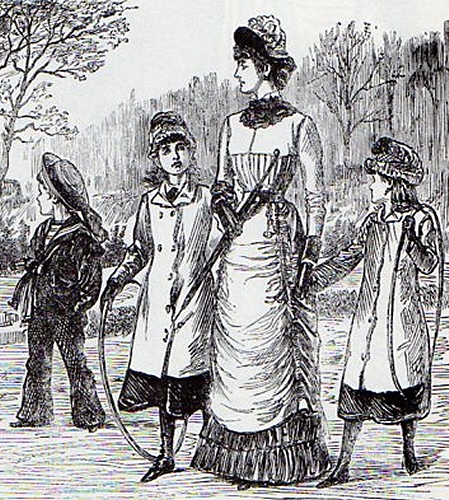
A mother with her children, 1879. Notice the girls’ loose hair and mid-calf skirts. The girls are showing this much leg because they are still young enough to play with rolling hoops. Cartoon from Punch.
Lynn Mally, of American Age Fashion, recently commented on skirt length as a signifier of age for young women, as seen in this 1930s pattern illustration.
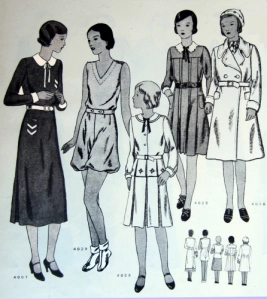
Back-to-School Clothes for ages 14 to 20, left, and 8 to 15, center and top right. The Delineator, August 1931.
There used to be rules for “proper young ladies.” The stages of wearing longer skirts, and putting your hair up, were important milestones for girls — and the men who might be attracted to them. For many decades before the 1920s, short skirts had been reserved for girls too young to marry. Then, in the twenties, women shockingly kept wearing short skirts after the age of 16. (For a previous post with illustrations on this topic, click here.)
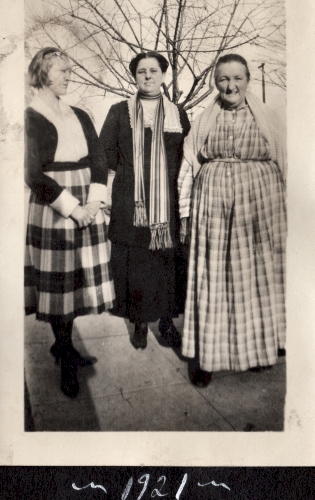
The persistence of fashion: Older people often cling to the fashions — and hem lengths — of their younger days. The youngest woman (left) wears the shortest skirt in 1921.
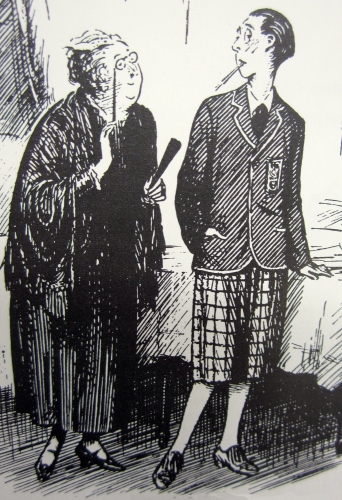
September, 1925. The older woman’s long skirt shows the persistence of pre-war fashion; the younger woman — here being mistaken for a man — has shockingly ‘shingled’ hair. From The Way to Wear’em.
Part of the shock of bobbed hair and 1920s fashions was that adult women were showing their legs to men who had grown up in the previous century, when showing the legs was considered indecent. The father of a 1920s’ flapper would certainly have been an adult in the era when married women still wore floor-length fashions, and pinned their long hair up off the neck. It’s not surprising that those men were upset when their wives and daughters bared their legs and cut off their long hair.
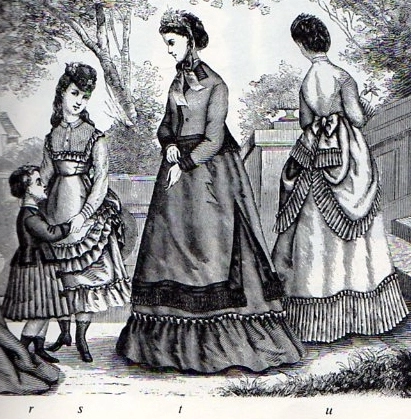
A male toddler (r) , a girl 10 to 12 (s), and two adult women, 1870. The twelve-year- old girl still wears her hair down, and shows her legs and ankles.
Generally speaking, throughout the 1800s, when a girl reached marriageable age — known as “being out” in society — her availability was signaled by her putting her hair up (as opposed to letting it hang down her back) and wearing skirts that completely covered her ankles, and, in some periods, her feet.
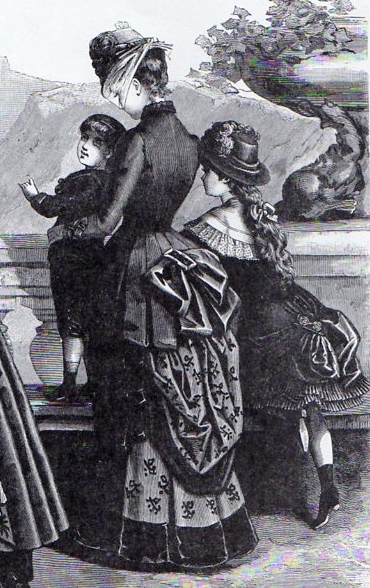
Mother and children, 1884. Mama’s hair is worn up. The girl aged 6 to 8 has hair cascading down her back. Her skirt barely covers her knees.
I’m currently re-reading Jane Austen’s Mansfield Park (published in 1814.) There is some discussion of whether the heroine — and other girls — are “in” or “out,” and the confusion that ensues when a girl appears to be older than she is. (In Pride and Prejudice, younger sisters Kitty and Lydia are “out” at a surprisingly early ages. Disaster ensues.)
A girl might come out by gradual stages, beginning by sitting at the dinner table with the adults in her family instead of eating in the nursery with younger siblings. Another step was dining with the adults when guests were present (she was not expected to volunteer conversation,) and later, of being included in dinner invitations to other houses. She would not attend balls until she was completely “out;” at that point, she was officially on the marriage market.
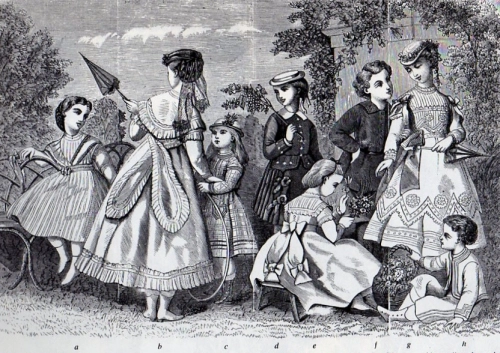
Children, 1868: (a), at left, is a girl about 6, (g), standing right with folded parasol, is 12; (b), left, with the longest skirt, is 14 or under; (e), sitting, is 8. The older the girl, the longer the skirt. There’s an appreciable skirt length difference between ages 12 and 14.
The closer she was to being out, the longer her skirts became. When a girl’s skirts reached her instep, and her hair was put up instead of hanging loose, a young man might reasonably deduce that she was “out” or soon would be. These rules were generally followed through the Victorian era, but were sometimes subject to changes in fashion: in the late 1860s and early 1870s a grown woman might put up her hair but allow some hair to hang down her back; her skirt might also be short enough to show her shoes.)
Other exceptions were sometimes made for sports clothing and for “the lower orders.” (Housemaids had to carry trays of food, pitchers of hot water, and heavy coal scuttles up and down stairs; they did not have hands free to daintily lift the front of a floor-length skirt out of their way.)
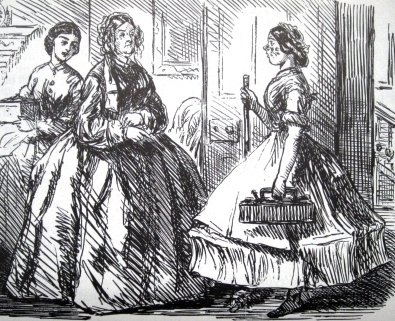
The servant is being reprimanded for wearing a hoop. Her skirt is shorter than that of her mistress, who is a lady of leisure. Dated 1863, from The Way to Wear’em.
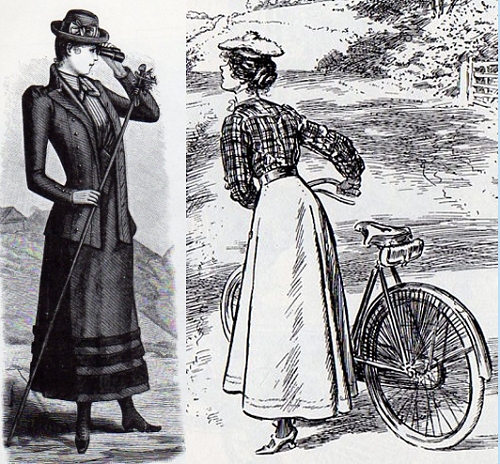
Shorter skirts were permissable for some sports: Left, mountaineering, 1891, and right, cycling, 1901. Both women have their hair up, signaling that they are adults.
The concept of “the persistence of fashion” explains why older people often cling to the clothing of their youth. We also have to make allowances for social class, economics, urban versus rural areas, and the likelihood that young people will adopt the newest fashions. The mother (at left) in this photo looks very well-groomed (the grandmother, right, does not!) And the youngest woman, center, has contradictory hair and skirt length:
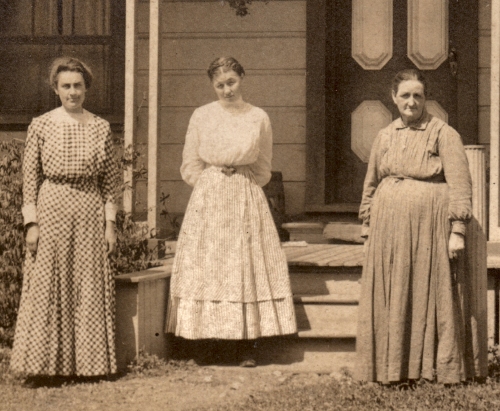
Three small town women, pre-WW I. The young woman in the middle has her hair up, like an adult, but her skirt is much shorter than her mother’s (left.) She might be dressed for a walk; she may be a teenager, not an adult; or she may be a young adult anticipating the shorter skirts of 1915.
This cartoon from 1898 shows a teenaged boy (who does not speak French) unsure of how to address a pretty young woman on the beach at Ostend:
Master Tom (knowledge of French — nil): “I say, do I call you Madam, or Madymoiselle?”
Mademoiselle: “When one does not know, one says Madame, n’est ce pas, Monsieur?”
The joke depends on the reader’s understanding the dress code. In 1898, readers would know from the girl’s loose hair and ankle-length skirt that she is definitely unmarried: a Mademoiselle.

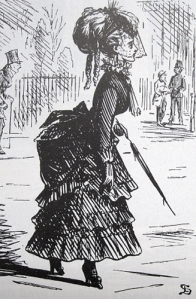
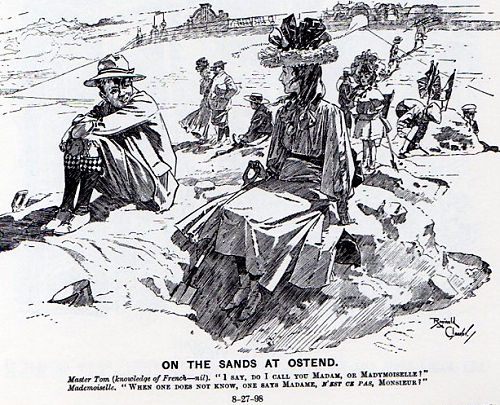
How interesting! I especially love that lost photograph; the one where the girls is giving mixed messages. It just goes to show how you can never rely 100% on these old “rules” .
Wonderful and informative. You should write a book. (I tell Lizzie that all the time.)
Thanks, but I know a little bit about a lot of aspects of costume, rather than a lot about one topic. The great thing about writing a blog is that I can post images and information — like a vintage ad or an exerpt from an article — on the blog as I find them, in case other people want to follow through on the rest of the research! The only time I got a book offer after a lecture was pre-internet, and I was overwhelmed by the difficulty of getting permissions for all the photos and paintings I needed to show (and with all those illustrations it would have been a very expensive book to publish.) Now I occasionally wonder how many of them have links or are in public domain? … maybe … someday… I’ll put it online.
Sorry, as usual I’m ages late in posting this comment!
An explanation that I’ve heard several times about putting your hair up was that in the 19 century a woman’s back of the neck was considered sexy (erogenous zone, I think is the technical term!). Before a girl came out a mother did not want her daughter to appear “sexy” because it would cause problems – her daughter might be sexually aroused. Once a girl came out the situation changed completely – the girl was on the marriage market and her mother wound WANT her daughter to appear “sexy” – so the hair went up to expose a sexy area. It’s also worth noting that the process of coming out was often instantaneous – one day a girl with hair down – the next day a lady with hair up.
In England I think it was accepted that “sexy” girls under the age of 15 or so were probably child prostitutes – so no respectable mother would want her young teenage daughters to look sexy.
Dinah
There’s probably not a square inch of the human anatomy that has never been regarded as erotic by somebody; I remember being warned about a fetishist who painted the toenails of unsuspecting library patrons who were reading while wearing bare-toed sandals! But I always associated the exposed “nape of the neck” with Japanese prostitutes in period movies. In Judeo-Christian and many other cultures, married women were often expected to keep their hair covered lest it attract men who were not their husbands. Nuns, of course might carry this to extremes — or cut off their hair to show that they were vowed to chastity. Women’s flowing hair is usually considered sexy. Generally, I think that innocent little girls could wear their hair down, but the combination of long, flowing hair and a maturing body was considered too tempting in most eras. You’ve opened another fun research topic!
Pingback: Hair Styles for American Girls, World War I Era (Part 1) | witness2fashion
Pingback: Mistletoe and Hemlines, 1920s | witness2fashion
Marie Lynn Hammond wrote a song called “Low Interest Account”, the opening lines of which are:
“The day I put my hair up
My mama said to me,
She said: ‘Darling, I’m gonna be frank.
Get out there and start looking
‘Cause I’m sure you will agree,
A good man is like money in the bank.'”
I’d never heard that song before. When I look at hairstyles from the 1870s or 1890s, I imagine how good it would feel to take all those hairpins out at the end of the day! For that matter, it feels good to let down a ponytail!